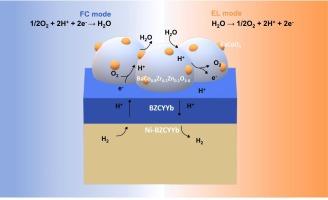A perovskite-type air electrode with in situ formed BaCoO3-δ nanoparticles for reversible protonic ceramic electrochemical cells
IF 13.2
1区 工程技术
Q1 ENGINEERING, CHEMICAL
引用次数: 0
Abstract
Reversible protonic ceramic electrochemical cells (R-PCECs) have demonstrated high energy conversion and storage efficiency, holding the grand potential to change the current energy technologies. R-PCECs can be operated in dual modes of fuel and electrolysis cells, which means that the oxygen reduction/evolution reactions (ORR/OER) at the air electrode side would be the performance-limiting component. Herein, we present a new perovskite air electrode BaCo0.8Zr0.1Zn0.1O3-δ (BCZZ), which is covered with a slight amount of active BaCoO3 (BCO) nanoparticles (NPs). At 650 °C, the developed BCZZ air electrode with BCO NPs shows a low polarization resistance of 0.128 Ω 2. The BCZZ cells demonstrate a maximum power density (Pmax) of 1.732 W cm−2 when utilized as the air electrode of R-PCECs in fuel cell mode and a current density of −2.62 A cm−2 in electrolysis mode (at 1.3 V) at 650 °C. Furthermore, the cells exhibit good stability for 80 h and 19 cycles of cycling tests in reversible operation at ± 0.5 A cm−2, with good Faradaic efficiency of 82.84 %. As X-ray diffraction and scanning transmission electron microscopy demonstrated, the enhanced electrochemical activity and stability are likely due to phase structure optimizations and increased oxygen vacancy concentrations after doping.

在可逆质子陶瓷电化学电池中原位形成BaCoO3-δ纳米颗粒的钙钛矿型空气电极
可逆质子陶瓷电化学电池(R-PCECs)具有很高的能量转换和存储效率,具有改变当前能源技术的巨大潜力。r - pcec可以在燃料电池和电解电池的双模式下运行,这意味着空气电极侧的氧还原/演化反应(ORR/OER)将成为性能限制因素。在此,我们提出了一种新的钙钛矿空气电极BaCo0.8Zr0.1Zn0.1O3-δ (BCZZ),它被少量的活性BaCoO3 (BCO)纳米粒子(NPs)覆盖。在650 °C时,BCO NPs制备的BCZZ空气电极具有0.128 Ω 2的低极化电阻。BCZZ电池在燃料电池模式下用作R-PCECs的空气电极时,功率密度(Pmax)为1.732 W cm−2,在650 °C的电解模式下(1.3 V)电流密度为- 2.62 a cm−2。此外,在 ± 0.5 A cm−2的可逆操作下,电池在80 h和19次循环测试中表现出良好的稳定性,法拉第效率为82.84 %。x射线衍射和扫描透射电子显微镜显示,掺杂后的电化学活性和稳定性的增强可能是由于相结构优化和氧空位浓度的增加。
本文章由计算机程序翻译,如有差异,请以英文原文为准。
求助全文
约1分钟内获得全文
求助全文
来源期刊

Chemical Engineering Journal
工程技术-工程:化工
CiteScore
21.70
自引率
9.30%
发文量
6781
审稿时长
2.4 months
期刊介绍:
The Chemical Engineering Journal is an international research journal that invites contributions of original and novel fundamental research. It aims to provide an international platform for presenting original fundamental research, interpretative reviews, and discussions on new developments in chemical engineering. The journal welcomes papers that describe novel theory and its practical application, as well as those that demonstrate the transfer of techniques from other disciplines. It also welcomes reports on carefully conducted experimental work that is soundly interpreted. The main focus of the journal is on original and rigorous research results that have broad significance. The Catalysis section within the Chemical Engineering Journal focuses specifically on Experimental and Theoretical studies in the fields of heterogeneous catalysis, molecular catalysis, and biocatalysis. These studies have industrial impact on various sectors such as chemicals, energy, materials, foods, healthcare, and environmental protection.
 求助内容:
求助内容: 应助结果提醒方式:
应助结果提醒方式:


